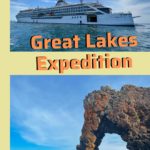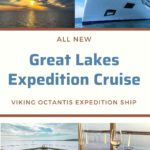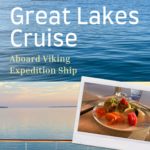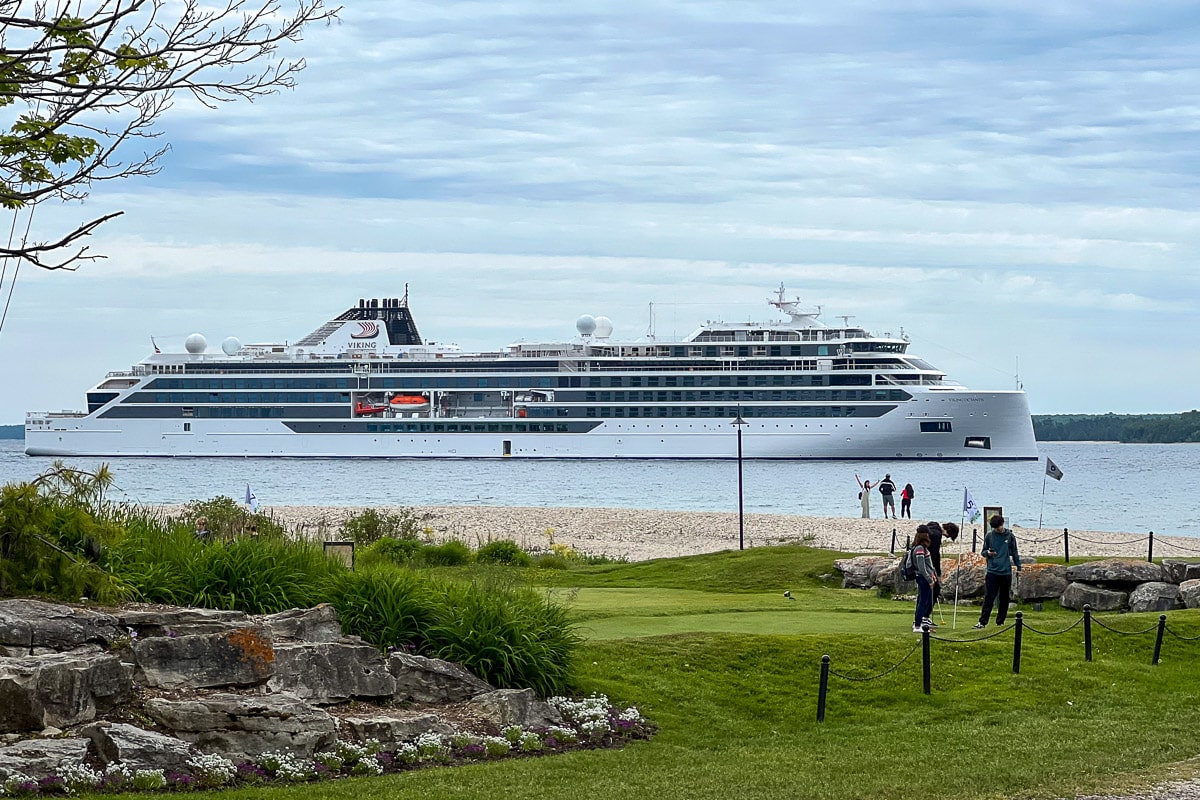
Finally, we can explore the Great Lakes on a ship worthy of these mighty and historic waters. Viking has launched several Great Lakes cruise itineraries with its expedition ship Octantis, soon to be joined by its sister ship Polaris.
With these custom-built ships, Viking is introducing a new style of touring to the region, combining scientific research expeditions with luxury cruising.
These brand-new polar-class expedition ships were designed and built with Antarctica in mind. But the demanding polar exploration features and craft specifications lend these vessels to the Great Lakes, too, and any other remote waters for that matter.
Note: This post on TravelPast50.com may contain paid or affiliate advertising links.
Table of Contents
Great Lake/Canada Expedition Itineraries
While commercial ships have been plying the Great Lakes and St. Lawrence Seaway for more than 200 years (especially since locks were built in the 1800s), and a number of passenger ships have come and gone, Viking Octantis is the first expedition cruise ship to explore the Great Lakes.
Viking’s flagship Great Lakes expedition, sailing all five lakes in fifteen days, starts in Toronto, Ontario, and finishes in Duluth, Minnesota.
We joined the Great Lakes Explorer itinerary, embarking in Milwaukee, Wisconsin, and culminating in Thunder Bay, Ontario. This eight-day tour covers Lakes Michigan, Huron, and Superior, with highlights in the Georgian Bay Biosphere Reserve, traversing the Soo Locks, and including renowned Lake Superior, the biggest of them all.
The Great Lakes/Canada season is short. In September, Octantis relocates to Antarctica with a longitudinal cruise from the United States to Ushuaia, Argentina. (In 2022 Polaris and Octantis set sail from Amsterdam, instead.) These longitudinal cruises are also a first in the industry.
Note: Would you prefer a short audio report about Viking Expedition Cruises? Scroll down to find our radio interview with Travel Writers Radio.
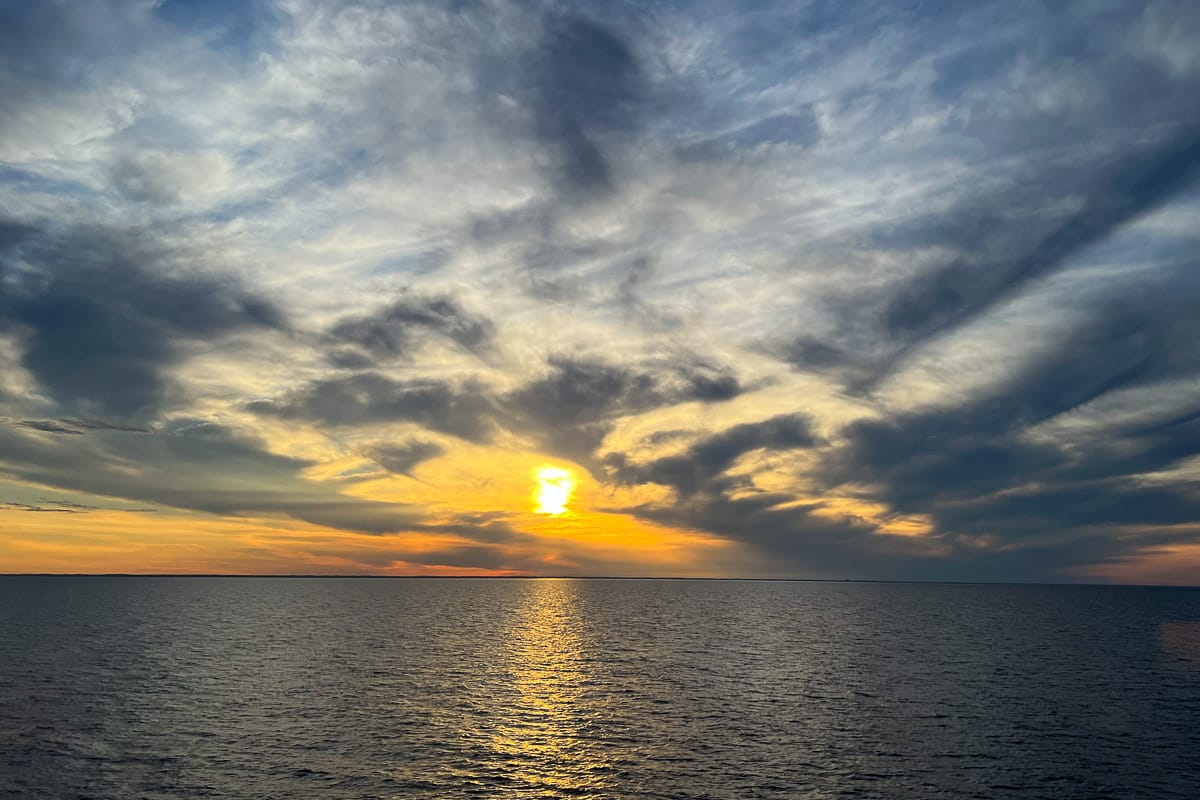
Viking Octantis on the Great Lakes
Certainly we were drawn to this exploration of the Great Lakes primarily because of the allure of the lakes and its shores. Lake Superior happens to be in our backyard, and we cover the North Shore region on our MNTrips Minnesota Travel blog.
For those who aren't familiar with the Great Lakes, be assured there are plenty of reasons to explore these North American waters and the shores and woods that embrace them.
The Great Lakes (west to east, Lakes Superior, Michigan, Huron, Erie and Ontario) span 4,530 miles of coast and account for 21 percent of the world’s freshwater, according to the NOAA Office for Coastal Management. Eight U.S. states and two Canadian provinces watch over the system, which also includes several UNESCO Biosphere Reserves,* seven U.S. National Park sites (counting two parks, three lakeshores, and two monuments), and dozens of Canadian National and Provincial Parks. Add countless local nature preserves, conservancies, and recreation areas to the list.
Note: This post focuses on what’s involved in an expedition-style cruise, with details about the Viking Octantis ship and onboard experience. For more about the Great Lakes Explorer itinerary, our various stops, excursions, and activities along the way, read our second post, A Great Lakes Cruise, Viking Expedition Style.
The Viking Octantis Ship
Even as the gorgeous Great Lakes scenery dominated our days, we couldn't help gawking at the ship and its features. After traveling on Viking Octantis, we’re certain this expedition ship is, in and of itself, one of the prize destinations of the itinerary. Everything from the engineering to the interior décor underscores the expedition style cruising, and we were impressed with every turn.
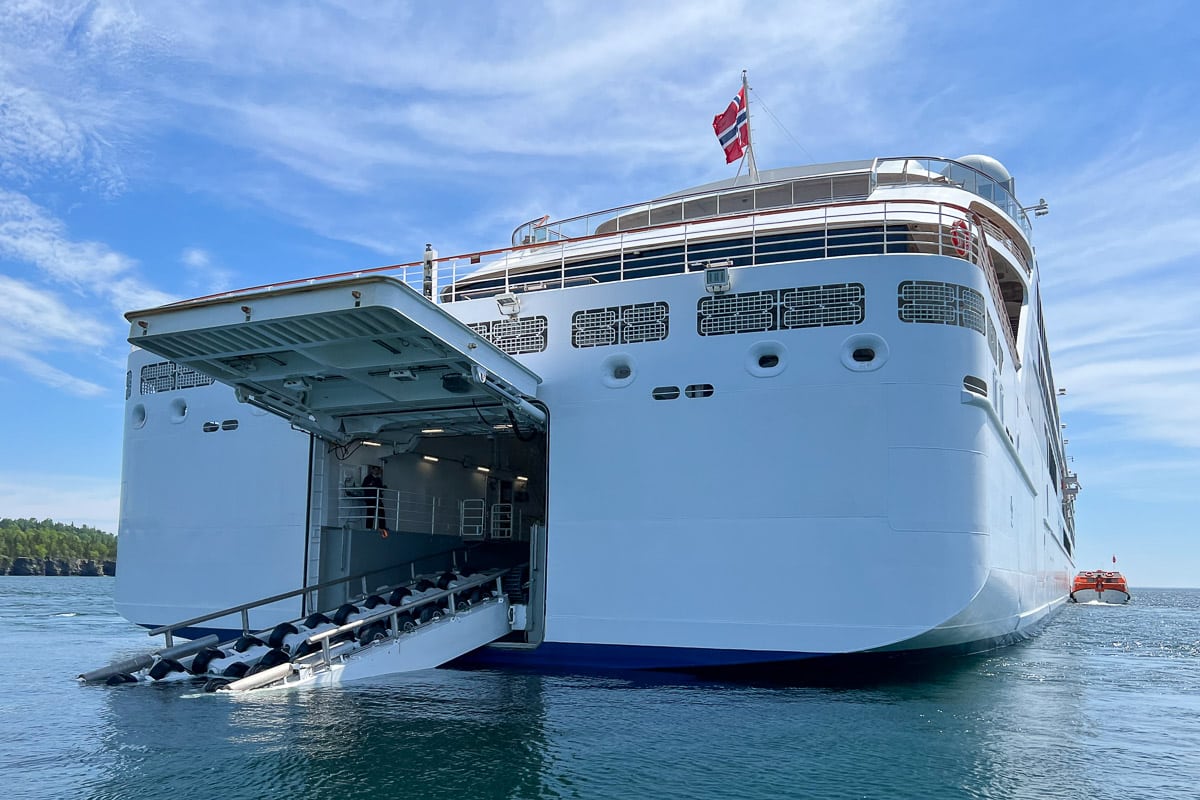
Engineering and Design
As built for the wild Drake Passage to Antarctica and the unpredictable waters of the Great Lakes, Viking Octantis (and its identical twin Polaris) exhibit state of the art engineering.
A comfortable, stable ride. Though we didn’t experience any severe weather during our trip, Octantis was steady as she goes, and quiet, even in gusty winds. Favorite features, from a passenger point of view, include a variety of stabilizing elements.
Rather than dropping a literal anchor (and potentially damaging lake and sea bottoms), Octantis is kept in position with a hovering system called Dynamic Positioning Mode. This reduces bobbing and can be manipulated to ease transfers from smaller craft. Fin stabilizers and a U-Tank stabilizer contribute to the smooth ride and remarkable lack of rolling. These elements are said to allow much quicker and stabler crossings of Drake Passage.
The hangar, where all the smaller craft are stored also serves as an “in-ship marina,” meaning passengers can embark and disembark the special operations boats from within the ship. The fully loaded SOBs are then wheeled into and out of the water through the aft hatch over hydraulic wheels. While this is fun on the Great Lakes, it must be really appreciated in the extreme climes of Arctic explorations.
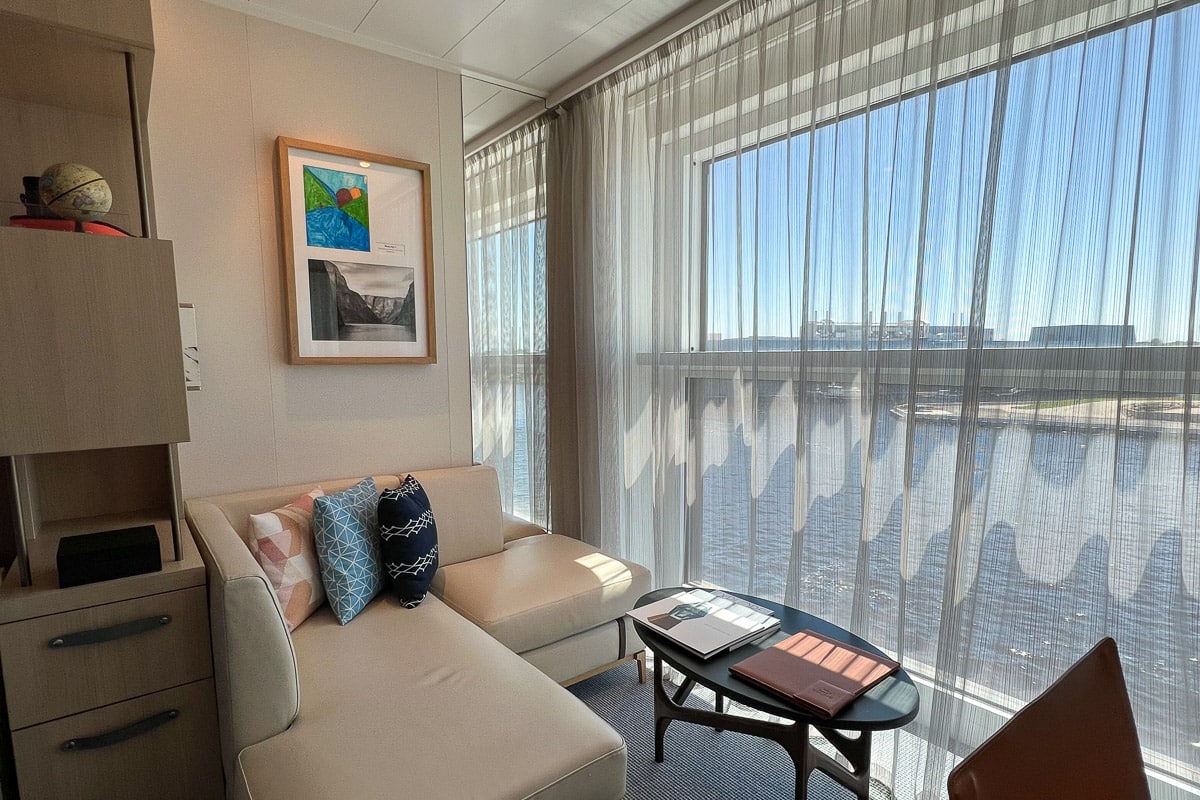
Cabins. It’s easy to observe all the comings and goings from the comfort of your cabin. All state rooms are positioned on the ship's exterior, and all include “Nordic Balconies,” a space-saving window feature that opens for fresh and viewing from the comfort of the cabin’s lounge area. I spent most of my free time perched right there, and loved watching the well-orchestrated deployment of the fleet of watercraft. Fine quality binoculars are provided. And we got a kick out of considerate details like the heated bathroom floor and heated drying closets for expedition gear.
Gathering spaces. Knowing that arctic destinations demand more than average time confined to the ship itself, the interior spaces for gathering are key. The Octantis gathering places range from the Aula lecture hall (with retractable screens revealing triple-deck floor to ceiling windows), to the Living Room (with an assortment of lounge seating and tables and chairs), to the library, and several observation areas and lounges, indoors and out. We took to the The Hide in the evenings for speakeasy-style drinks and chatter. See if you can find it!
The surprise to me was that whether I wanted a quiet corner to myself or a place the talk with a friend or small group, we could always find the perfect space.
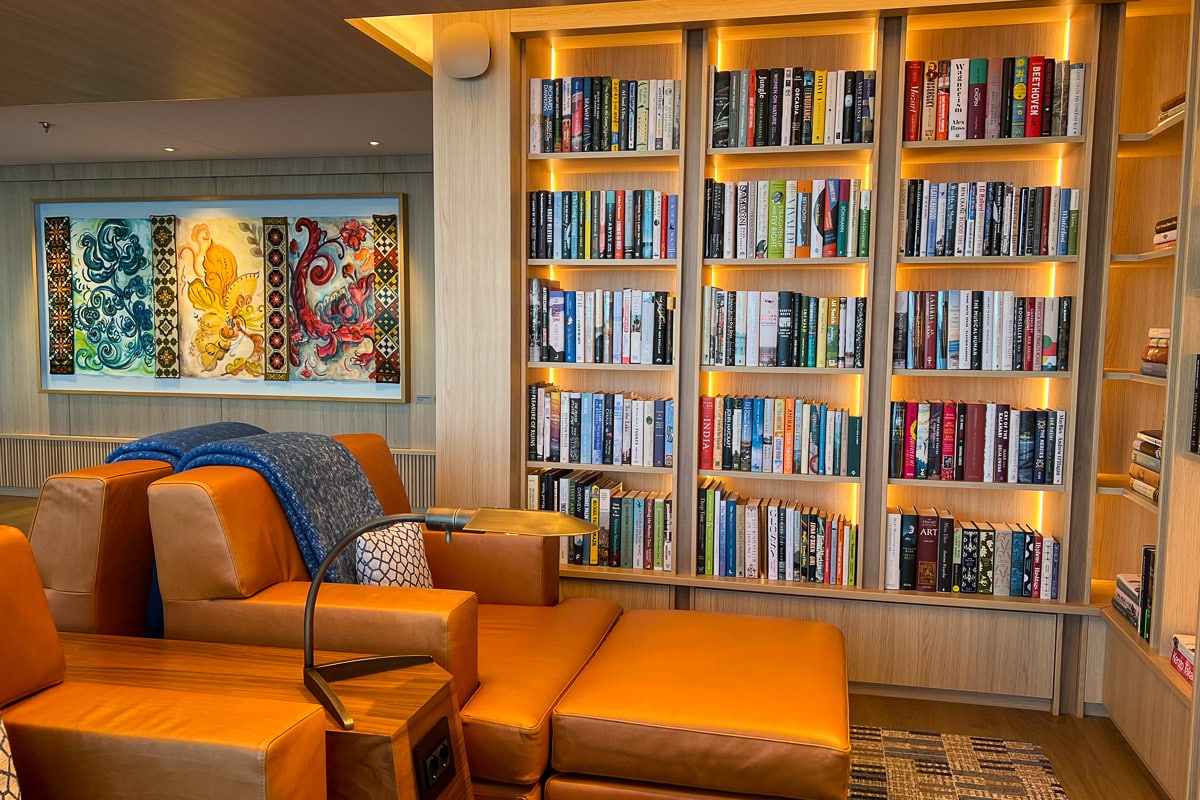
Art, Books, and Décor
The ship is filled with books, so many that I wanted to stow away for another week – or season – to investigate the stash. The library – spread across several lounges and including the spa waiting room and other select nooks – has been curated with Viking’s science partners.
The art collection enhances the sailing experience, referencing famous world explorers and expeditions, wildlife, Viking destinations, and natural history through artifacts, photography, sculpture, textiles, etchings, and painting. There’s plenty of exploring to do right onboard.
The overall Scandinavian design relies on light woods, clean lines, natural textiles, warm spaces, and open air and large window observation areas. You'll discover lots of considerate touches, like the leather covers to metal door handles. In the Viking world, luxury is defined by simplicity and these small details, not by opulence.
By the way, fourteen classic explorer books are quoted in displays at the meeting place outside the Aula. We've listed their titles in our post about the Great Lakes shore excursions, A Great Lakes Cruise, Viking Expedition Style.
Notably, not on the list is “No Horizon Is So Far,” by Ann Bancroft and Liv Arnesen, the ‘godmothers’ of Viking’s Octantis and Polaris ships. Read the story of their journey across Antarctica.
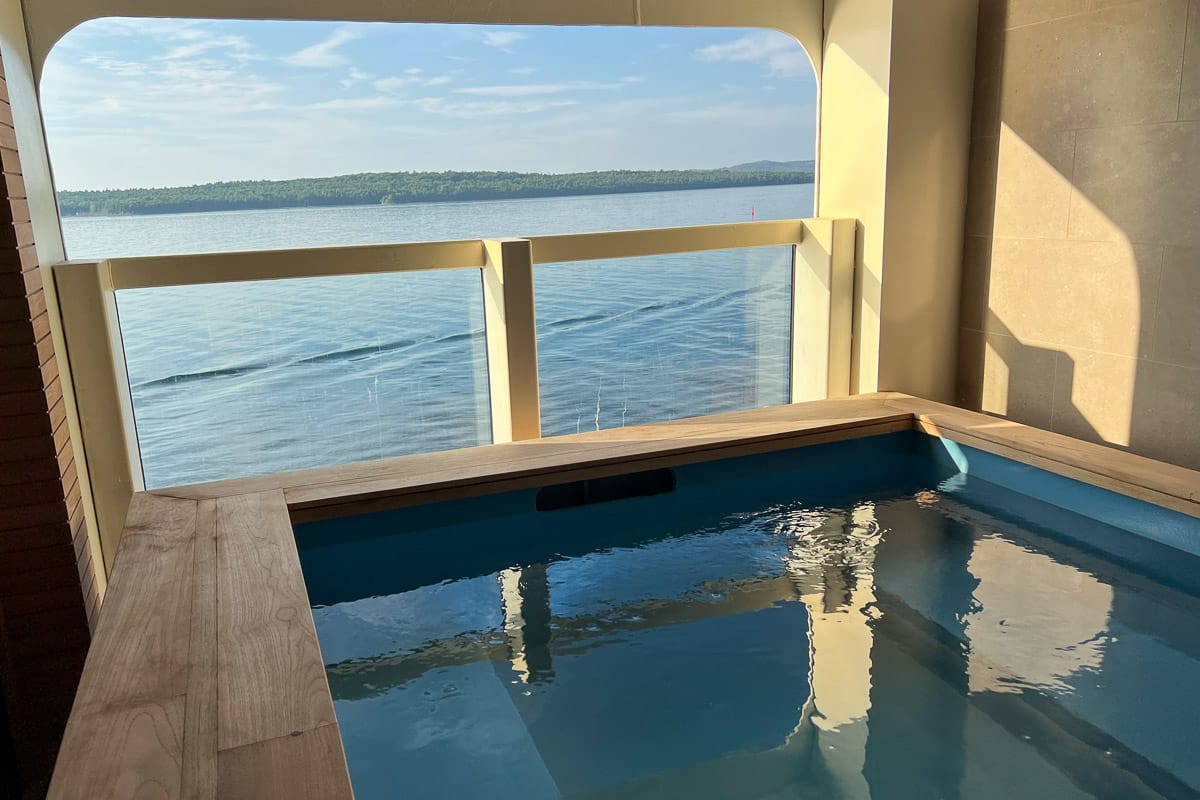
The Spa
The Octantis spa features all the best Scandinavian wellness bells and whistles. The array of facilities surpassed my expectations, which were admittedly vague. Try a giant whirlpool with built in lounge seats, a protected open-air hot tub (the Badestorm), sauna, steam room, and three fun ways to cool down post-sauna: the cold bucket of water, the snow grotto, or the variable environment shower. I managed to squeeze in two visits to Liv Nordic Spa. Other inviting thermal pools in the aft of the ship flow inside and out.
Spa services are top notch (I scheduled a facial and foot reflexology), and I’m not even counting the spacious gym which I didn’t visit.
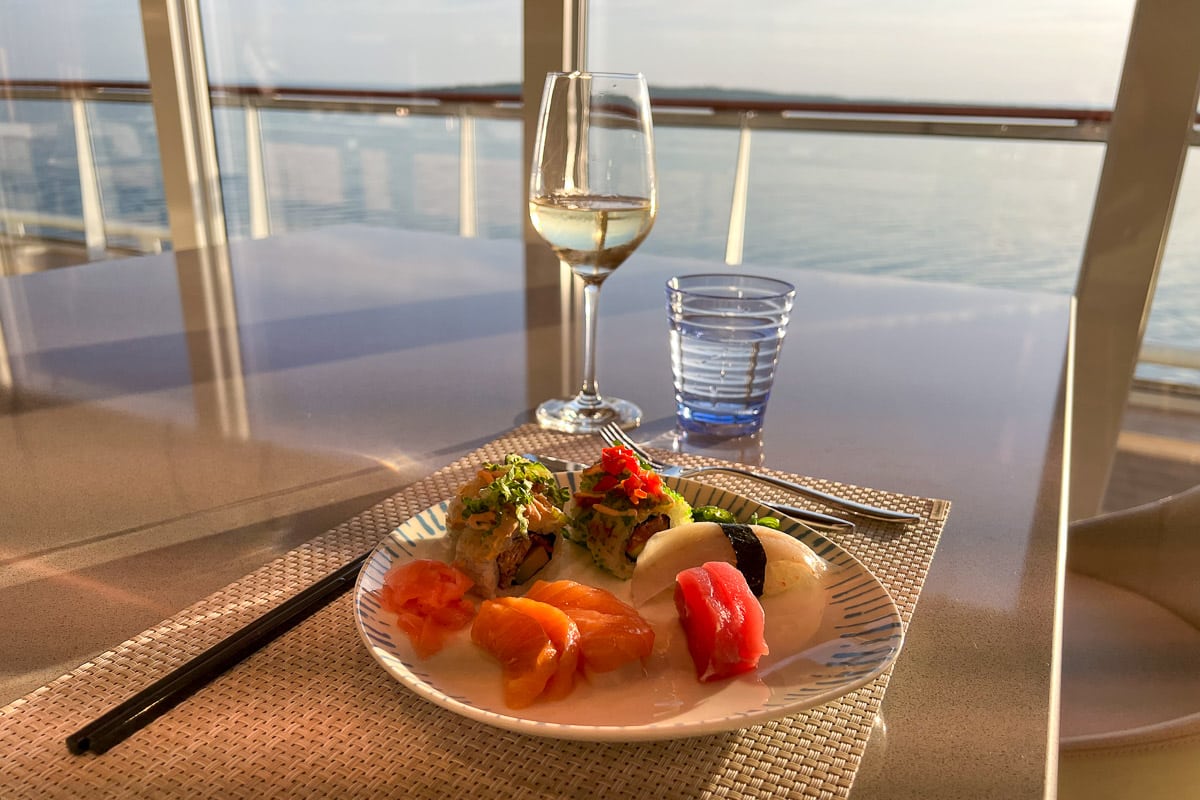
The Restaurants
I’m not one to first think ‘Food!” when I hear about a cruise, but I found myself carefully planning where I’d eat next so that I could try everything and return to favorite places. Full service restaurants Manfredi and The Restaurant are worth reserving early on in your voyage so that you can plan to revisit.
For breakfast, lunch, or late night fare, try Mamsen, a wonderful example of Scandinavian fare named for the Hagen matriarch. Decorated with wooden cross-country skis and serving delectable open face sandwiches, I really was transported to Sweden (which I know better than Norway). Get the waffles when they are hot off the skillet.
The World Café provides wide choices and excellent fare for all meals, buffet style with table service for beverages. Alongside World Cafe is The Grill, where you can request tasty made-to-order burgers. And nearby is the sushi bar, open evenings offering crab legs and pleasant views with the irresistible sashimi and rolls.
Again, I never felt crowded or rushed at meal times.
Passengers generally raved about the quality of the beef (both steaks and burgers), the daily sushi options, and some surprise entrees, like roasted leg of lamb.
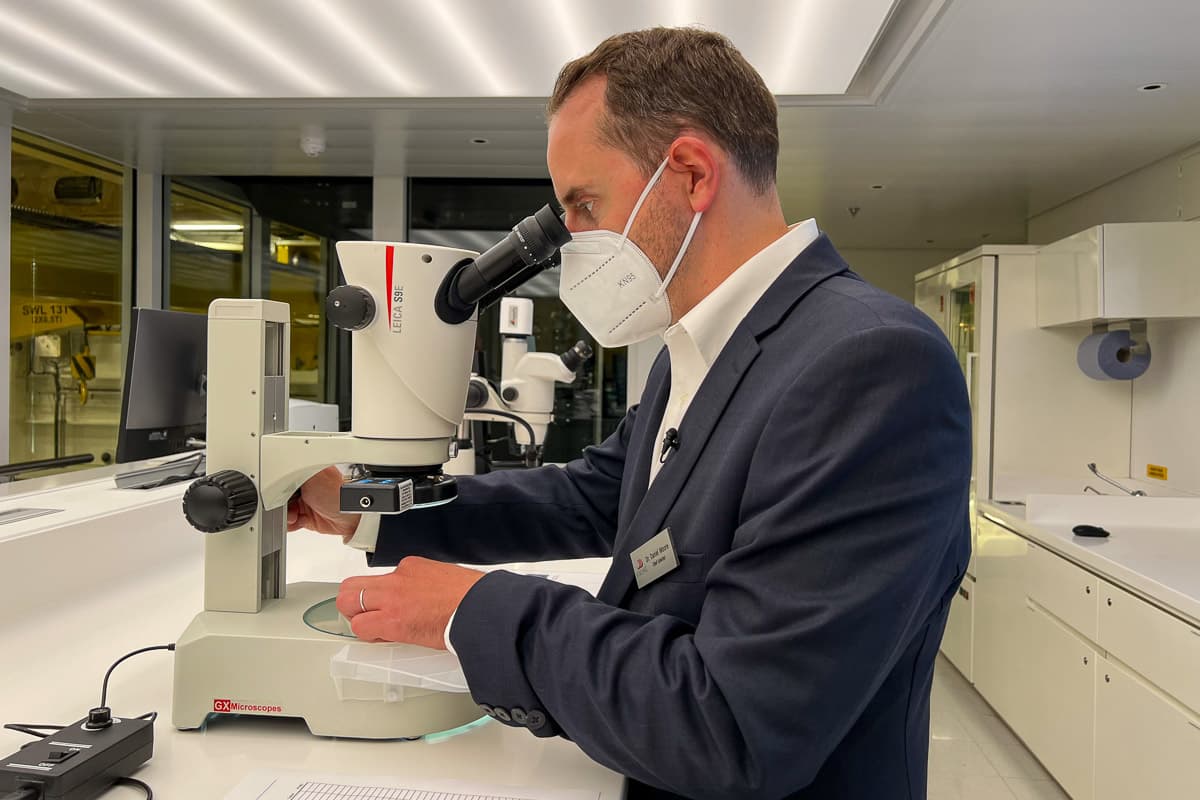
The Research and Science
A small but vital hub on the Octantis is the wet/dry laboratory at mezzanine level overlooking the hangar. A couple of Viking’s numerous science partners, University of Cambridge Scott Polar Research Institute and NIVA (Norwegian Institute for Water Research) helped design the lab. Scientists gather here for exchange, and small groups of passengers visit to learn about the ongoing research and to help with hands-on practical work.
“Nothing is for show. The work is always tied to science and monitoring.” – Dr. Damon Stanwell-Smith, Science and Sustainability
Though other expedition ships have labs, to be sure, this is unique in that the research work is embedded in and continually funded by Viking operations. As Viking's Chief of Science and Sustainability Damon Stanwell-Smith pointed out, that means scientists who might normally spend 40 percent of their time chasing grants, can work more or less continually. Guests not only help support this research with their fare and tax dollars, but are able to participate in it.
The strategic science partnerships are key, demanding Viking research be conducted in the real world and reviewed and refined by peers. Here are some of the most important relationships:
- With NIVA, Octantis collects water via its “ferry box” on an ongoing basis. Among other things, it examines the water temperature, salinity, oxygen and chlorophyll levels. A special project is the collection and monitoring of microplastics in the water.
- With University of Cambridge, Viking Octantis conducts multi-beam sonar seafloor surveys, learning about glacial retreat, shipwrecks, underwear volcanoes, and unique landscapes.
- With University of Western Australia, baited remote underwater videos are captured to study marine biology.
- In partnership with NOAA (National Oceanic and Atmospheric Administration), Viking Octantis has become the 103rd weather station in the world, and the first civil ship among the elite group. As such, it launches weather balloons regularly from the ship in coordination with NOAA and all the other stations. Passengers can observe immediate readings from the radiosonde dangling from the weather balloon as it rises 30 kilometers into the stratosphere and returns readings of temperature, humidity and other key data used in weather forecasting.
- Viking works with Cornell Lab of Ornithology on the study of birds. With Cornell’s support, Octantis and Polaris are specifically equipped with bird-safe lighting modes. Cornell Lab is the creator of the Merlin bird app which we love and recommend for identifying birdsong. It's a joy.
Six scientists onboard with a team of up to 20 are excited to share their experiences and insights with passengers. Our week included presentations on geology, birds, weather, and microplastics, plus documentary films on humpback whales, Antarctica, National Park adventures, North America, and wonders of the sea. It's impossible to fit it all in, but don't miss out on conversations with explorers whenever they might occur. Even staff piled into The Hide to hear Damon's stories of his expedition career.
Currently, passengers are helping gather microplastics data, since a massive database will be required for analysis. As Chief Scientist Dr. Daniel Moore demonstrated, it’s the microplastics rather than the more commonly portrayed fishing nets or 6-pack rings that most threaten marine life. Because microplastics (small particles from fabrics, for example) simply break up into smaller pieces but don’t disintegrate, they can easily get into the systems of the smallest organisms, eaten by smaller fish then larger fish and so on up the food chain. Yes, we want to know more.
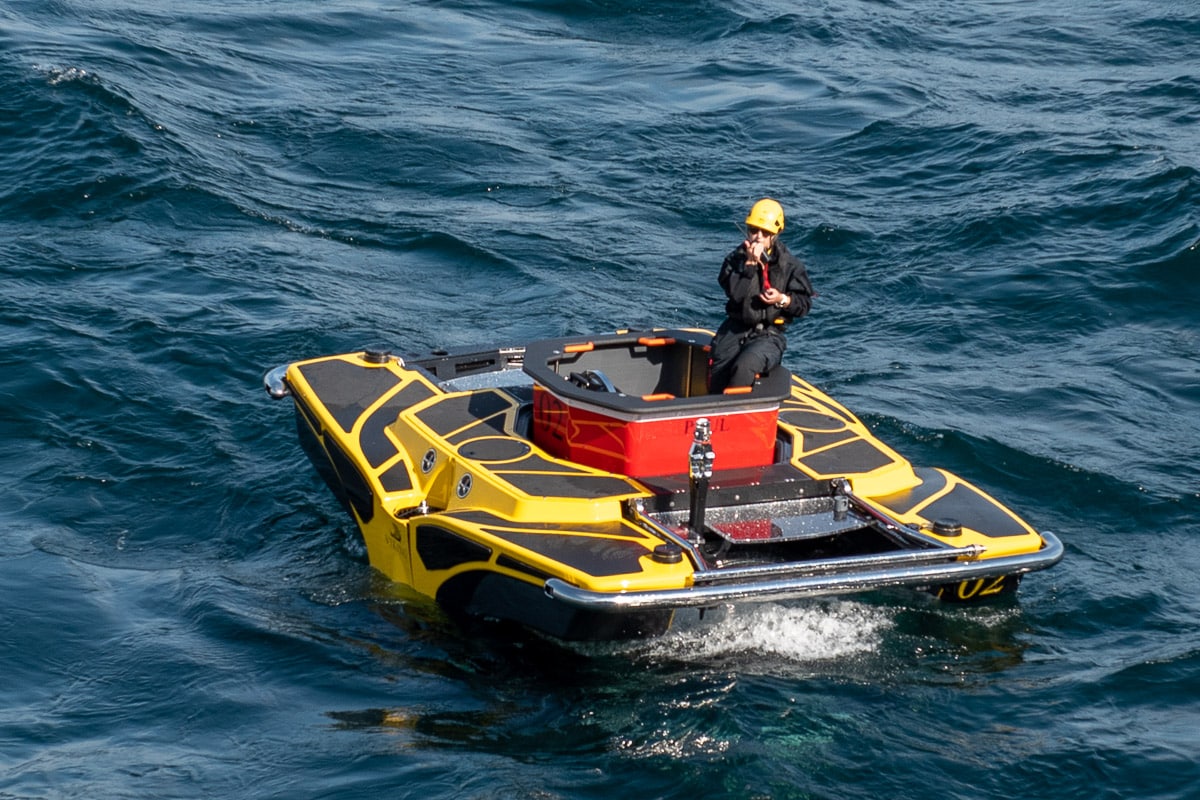
Expedition Fleet
All the comfort aboard Octantis is complemented by the fun and adventure of the ship's fleet of watercraft. Octantis has all the equipment for your adventure at hand. We can flippantly call them toys, but these boats are all used for research as well. And we’re not talking cheap toys. The price tag on the precious subs, again designed to double for passengers’ benefit and research, climbed from the originally budgeted quarter million dollars to over $1 million.
Octantis carries two tender boats to shuttle guests to shore where there are docks, two submarines, 17 zodiac boats to zip people to landings or other vessels, 15 double kayaks, and two military grade special operations boats (SOBs).
For exploration and just for fun, try all the equipment if you can.
Submarines Each sub seats six plus the pilot. Passengers are vetted to assure ability to get in and out of the sub from a zodiac. The views in the Great Lakes, mind you, are not stellar (with silt bottom), but hey, if you have the chance, do it.
Kayaks Guests are outfitted with dry suits. Though not as cold as the arctic, the Great Lakes, especially Superior, are more comfortable to paddle with protection.
Special Operation Boats These high-speed cruisers, sort of like jet skis on steroids, are great fun for sightseeing a little further afield from the ship. Dress warm.
Zodiacs The serviceable zodiacs get you close to the water and, if it’s windy, will get you wet. Prepare to enjoy! “Wet trousers” (to keep you dry) are available to all guests. (Except for kayaking, I stuck to my usual fast drying hiking pants.)
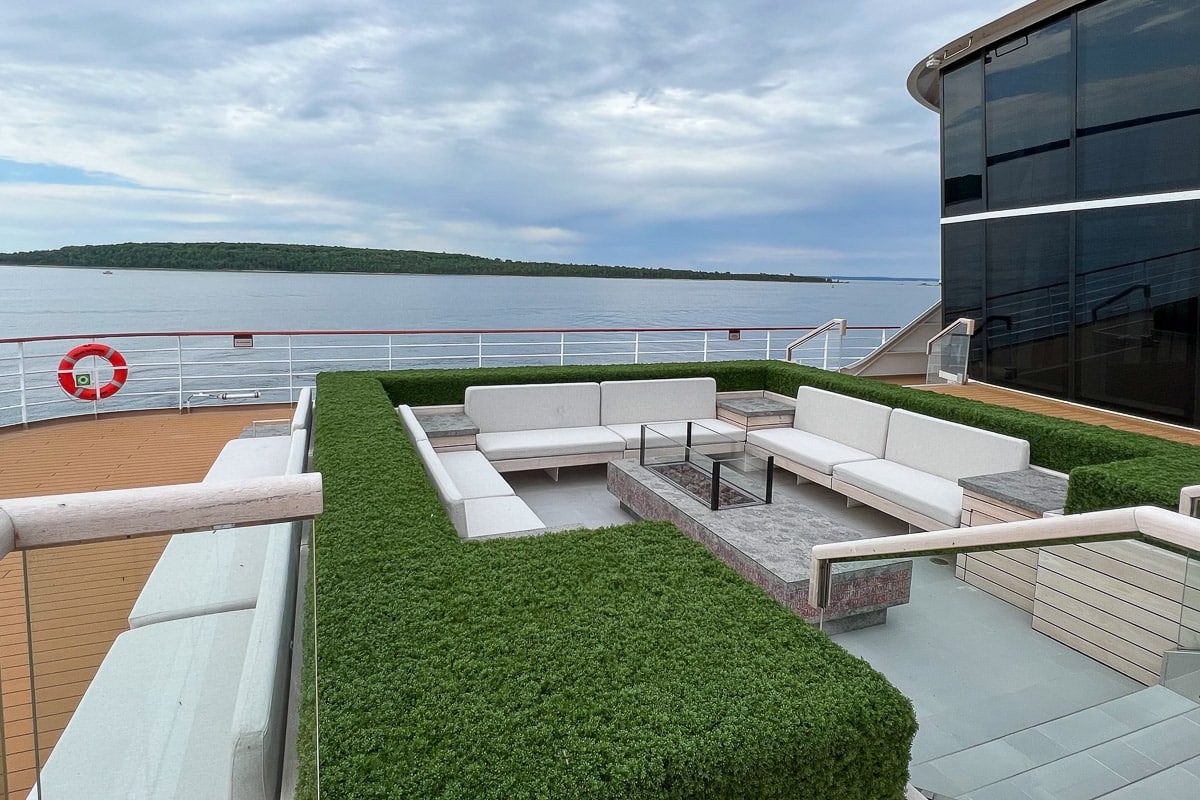
Expedition Style Cruising: What to expect
It’s best to know what expect before you jump on a cruise for a week or more. Being a hybrid of expedition and passenger ships, the Viking Octantis offers experiences unlike those found on either river or ocean cruises. We predict its guest profile will evolve, too, as Viking attracts new explorers to some of the most remote destinations of the world. Think adventure and classy comfort, participation and learning, an international crew and cuisine, and a purpose-built ship that facilitates small and large group gatherings, observation of the wild, and personal reflection.
Number of passengers
The ship itself is sleek and comfortable (more on that below), accommodating up to 378 passengers and 258 crew. That’s less than half the passenger count for Viking’s ocean ships (930), and just double the capacity of the average river longboat. Aboard Viking expedition ships there is plenty of elbow room in the common areas and comfortable privacy in the cabins.
Ports of call
On our Great Lakes Explorer itinerary, Octantis docked in Milwaukee and Thunder Bay for embarkation and disembarkation. Otherwise, she anchored at all the intermediary stops and relied on the ship’s fleet of boats to provide transport to shore or water activities. In most places, guests can choose from various boating activities or hikes, or hop a ride to shore for independent exploration.
Off-ship activities and shore excursions
The expedition ships’ focus is (apart from onboard research and entertainment activities) on adventurous activities both ashore and on the lakes. These utilize the ship’s fleet of boats – including tenders, zodiacs, kayaks, special operations boats, and submarines – to whisk guests off and on the Octantis.
The upshot for adventurers: opportunities for a variety of moderate to challenging hikes, for kayaking, and for some brisk boat rides. (Note: water trousers are provided to all, and dry suits to those who are kayaking.)
Expect to spend some time getting briefed and equipped for these adventures.
Onboard enrichment
Onboard, a team of scientists is actively engaged with a range of science partners, conducting research on water, weather, marine life, and related climate and environmental concerns. Passengers can participate in the research and are offered a variety of lectures, documentaries, lab visits, libraries and time with expedition and science staff to satisfy the most curious minds.
Physical requirements
Those who aren’t keen on or able to move from one vessel to another (when one or both might be bobbing in the water) may not enjoy the shore or water activities, and should consider whether staying aboard the Octantis for the duration will satisfy them. Likewise, some of the hikes can be challenging, requiring scrambling up the shores' rocky hills and finding footing on paths strewn with tree roots, stones and rocks. (The ships amenities noted here will occupy most any traveler not interested in venturing off ship. But still, understand your own expectations and limitations.)
Expect and accept changing plans
Everything is weather dependent, and weather can change quickly. High winds may cancel kayak or sub outings. But by the same token, special wildlife sightings can mean extemporaneous seminars or excursions. Expedition cruises by definition are resilient and adaptive to current situations.
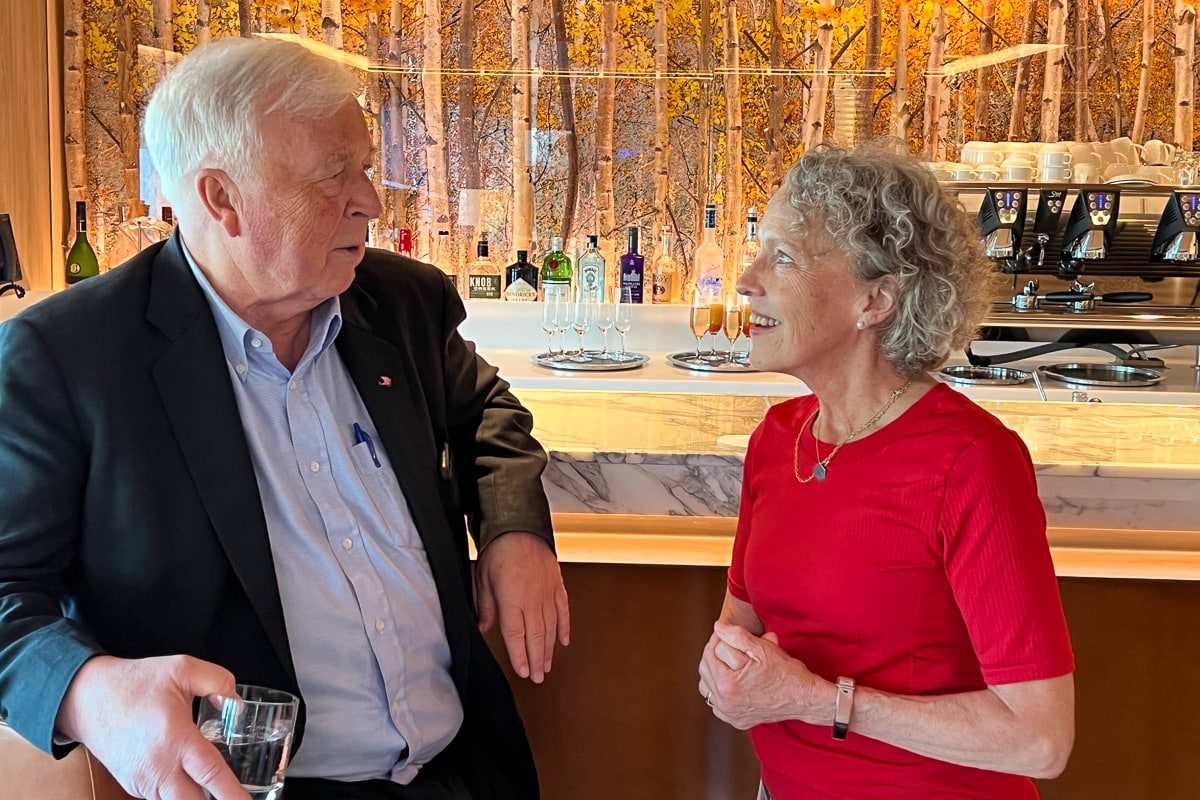
Footnotes and FAQ
*According to Central Michigan University, there are nine Biosphere Reserves in the Great Lakes Basin, three of which are in the United States. A coalition of 131 U.S. and Canadian majors is urging the entire basin become a UNESCO Biosphere reserve.
In June 2022, UNESCO announced 11 new biosphere reserves, bringing the world network of Reserves to 738 sites in 134 countries.
Frequently Asked Questions
Excursions. We'll cover more about the ports of call in the next post, coming soon. You'll also find our tips on what to pack for the Great Lakes expedition cruise there.
Passport. Yes, have your passports ready to go. It's required. The ship and all its passengers are subject to Canada and U.S. passport control. Fortunately, Viking's guest services department handles this, usually while you are sleeping.
Cost. You may find expedition cruise prices a bit steeper than you anticipated. The cost is largely due to the exclusive nature of these cruises: relatively small guest capacity, a short season, and significant staff to guest ratio. Expedition cruises, of course, require a more skilled group of guides and leaders, too.
On the plus side, when you sail with Viking, you won't have a lot of extra charges. All of the onboard programming and nearly all of the excursions are included at no additional charge. Wine is included at lunch and dinner. The space and gym facilities are included. Polaris and Octantis expedition ships are already booking into 2023.
What's the Jones Act again? For those wondering why this itinerary ended in Thunder Bay versus, say, Duluth with its more accessible airport, just refer to the Jones Act. That's the 1920 Merchant Marine Act that was designed to favor U. S. built ships and crews. Today it effectively disallows ships under foreign flags to sail from one U.S. port to another. So if you embark in the U.S., expect to disembark in Canada, and vice versa.
What about Viking's long-awaited Mississippi River cruises? Partly due to the Jones act, and partly so Viking can operate to its own standards while complying, the process has been slow. But with American partners and crew, Viking's Mississippi River Cruises are now booking itineraries from 2022 through 2024.
More cruise posts. We've stuck mostly to river cruises until now. Read about all our river cruise experiences here.
Audio Report
Brand new expedition-style cruising, combining luxury amenities and service aboard a working scientific research vessel, is the topic of the conversation with Graeme Kemlo (based in Melbourne, Australia). Kris reports on Viking Octantis's Great Lakes options as well as its longitudinal itineraries connecting to Antarctica.
Occasionally, part of our travels are provided complimentary, but we never relinquish editorial control. Paid content is clearly labeled as such.
Up Your Travel Skills
Looking to book your next trip? Use these resources that are tried and tested by us. First, to get our best travel tips, sign up for our email newsletter. Then, be sure to start your reading with our Resources Page where we highlight all the great travel companies and products that we trust. Travel Accessories: Check out our list of all the accessories we carry to make getting there and being there a lot easier. Credit Cards: See our detailed post on how to choose the right travel rewards credit card for you. Flights: Start finding the very best flight deals by subscribing to Thrifty Traveler. Book your Hotel: Find the best prices on hotels with Booking.com. See all of the gear and books we like in one place on our Amazon shop.Got a comment on this post? Join the conversation on Facebook, Instagram, or Threads and share your thoughts!

